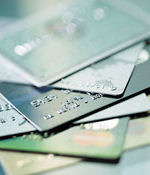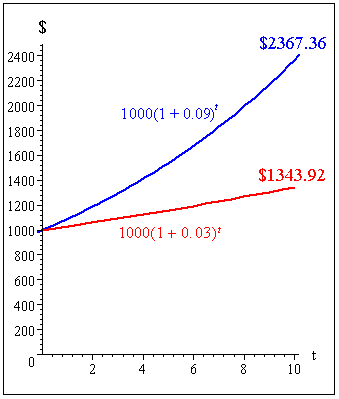2. Credit Cards
by M. Bourne
Disclaimer
This discussion is simplified.
Interest rates are changing all the time - check your local banks for latest rates.
This site does not give investment advice.
What Banks Earn from Credit Cards
The world has gone mad on credit cards.
American consumers currently owe $872 billion in credit card charges. (Source: the balance)

Between 1993 and 2000, the industry more than tripled the amount of credit it offered to customers, from $777 billion to almost $3 trillion. The average cardholding household now has six credit cards with an average credit line of $3,500 on each - for a total of $21,000 in available credit. (Source: Demos)
Now let's see why banks love to give you a credit card. We pay extraordinarily high interest on credit cards. Typical advertised amounts are:
| USA: | `9%` p.a. |
| Singapore: | `9%` p.a. |
| Australia: | `13%` p.a. |
| Japan: | `15%` p.a. (What a ripoff!) |
| UK: | `9%` p.a. |
| Canada: | `10%` p.a. |
| Mexico: | `12%` p.a. |
(Japan is incredible - they pay nothing to depositors and yet charge `15%` for credit card debt - even up to `28%` for overseas cashing service!)
Anyway, that `$1000` we have given the bank is loaned to some sucker with a credit card, who pays `$90` per year for the privilege.
Are you getting the picture? The banks pay you `$30` and they charge `$90`. Good deal - for them.
But wait - there's more.
Credit card companies also make mountains of money from fees.
- They often charge an annual fee for the card.
- They can charge fees if your payment is late.
- They can charge a fee if you pay by cheque (or "check" in America-speak) and that cheque "bounces" (that is, there is not enough money in the cheque account)
Credit Card Advertising
Check out Misleading credit card advertising for a recent example of questionable practice.
When you get your statement from the credit card company, it will indicate a "minimum amount payable". This is normally 2% of the amount due. Many customers pay this minimum amount and are then charged interest on the remaining amount. How much interest? The customer may have signed up for a credit card at some "sweetheart" beginning rate. But if just one payment is late, that interest rate can rise to whatever the company likes - between 20% to 30% is common.
In the US, credit card companies can change the interest rate whenever they like (after giving 15 days notice) - even after you have made a purchase. There's nothing wrong with them being able to change rates, since they need to remain competitive and official interest rates change all the time. But from the customer's point of view, you need to make a decision to buy based on the current cost of borrowing money. If that cost changes after you buy, you could be heading for trouble.
A lot of credit card owners love to buy on impulse.
"I want it now - I don't have the cash - but I do have the plastic. What the heck - I'll pay it off later."
There is no problem with this as long as you pay it all off within the interest-free period (usually a few weeks). But miss that deadline, and it's gonna cost you.
The Amount Banks Make on Credit Cards
Let's assume you cannot pay your `$1000` credit card debt and you allow it to build up year after year.
In the case of the USA, the interest rate is `9%` and the debt owing after `10` years is `A = 1000 × (1.09)^10 = $2367.36`.
So the debt has more than doubled. Oh, and for the guy who gave his `$1000` in the first place? How much does he have now? Just `$1343.92`. So the bank has creamed `$2367.36 − ` `$1343.92 = ` `$1023.44` from the deal. Not bad - for them.

Value of $1000 after 10 years, at 3% (red) and 9% (blue) p.a.
Note: This illustration assumes the credit card issuer is "kind" and does not charge any late fees (fat chance) and that the interest rate remains at `9%` throughout the entire period (even fatter chance).
If the credit card company charges a `$10` late fee (conservative) per month and increases the interest rate to `29.99%`, the amount owing after `10` years would actually be `$14975.25`.
Financial Lessons From All This
Did you know?
Under the daunting name of "universal default", you can be penalised by Card Company A if you default in paying Card Company B's debt. That is, a bad record with one card can be shared and the effect can "spill over" to another card - costing you more in interest and fees for both cards.
- Don't be a borrower - it's a mug's game. Only borrow for those huge things that nobody can pay cash for - your first house, and maybe your first car. But make it a small house and a small car.
- Have a credit card, but pay it off each month within the interest free period.
- It is better to use a debit card. If you have the money in the bank, you can afford to buy it. Otherwise, take a cold shower and wait.
- If you can't pay cash for it - you can't afford it.
- Be very wary of the banks and their promises. Read the fine print (which is deliberately written in confusing mumbo jumbo.)
- Tom (see the chapter intro) should forget the fancy car and pay off his college loans and credit card debt first. Then pay off any future credit card bill during the interest free period.
Money Maths Lesson Plan Suggestions - Interest & Credit Cards
- Simulate a credit card scenario. Make and issue actual cards with current interest rates indicated on them. Give the students an "income" per month. Get students to "buy" several items. Get them to calculate the debt they will have after 6 months, 12 months, 5 years. Compare this to how long they would take to pay cash for the item.
- Get students to do comparison shopping for credit cards. What is the real cost after taking in consideration yearly charges, late fees, loss of interest free period?
Footnotes
- In the odd world of credit card financing, those who pay off their full loan on time each month are called "deadbeats" by the card companies. (The credit card companies don't like such customers because they don't make any money from them).
- Customers who continue to add to their debt and pay a lot of interest, are called "revolvers" because they are using a "revolving line of credit". The card companies love such
suckerscustomers. - An interesting site produced by Visa Cards Practical Money Skills for Life is actually quite a good resource. But be aware - they want your money...!